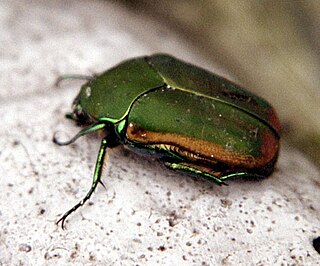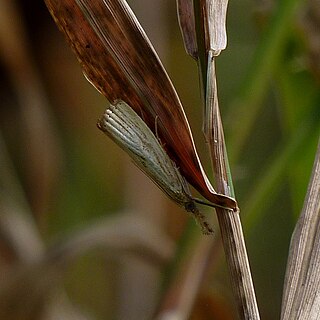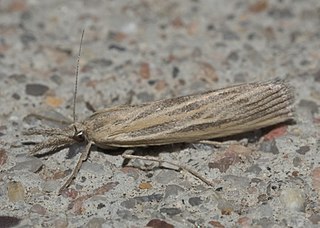
Crambidae comprises the grass moth family of lepidopterans. They are variable in appearance, with the nominal subfamily Crambinae taking up closely folded postures on grass stems where they are inconspicuous, while other subfamilies include brightly coloured and patterned insects that rest in wing-spread attitudes.

The Pyralidae, commonly called pyralid moths, snout moths or grass moths, are a family of Lepidoptera in the ditrysian superfamily Pyraloidea. In many classifications, the grass moths (Crambidae) are included in the Pyralidae as a subfamily, making the combined group one of the largest families in the Lepidoptera. The latest review by Eugene G. Munroe and Maria Alma Solis retain the Crambidae as a full family of Pyraloidea.

Cotinis mutabilis, also known as the figeater beetle, is a member of the scarab beetle family. It belongs to the subfamily Cetoniinae, comprising a group of beetles commonly called flower chafers since many of them feed on pollen, nectar, or petals. Its habitat is primarily the southwestern United States and Mexico. Figeater beetles are often mistaken for green June beetles and occasionally Japanese beetles, which occur in the eastern US.

Fissicrambus is a genus of moths of the family Crambidae.

Niphograpta is a genus of moths of the family Crambidae. It contains only one species, the water hyacinth moth. It is native to the Amazon basin, but has been introduced in North America, Africa and Australia to control the spread of water hyacinth.
Raphiptera is a genus of moths of the family Crambidae. It contains only one species, Raphiptera argillaceellus, the diminutive grass-veneer, which is found in eastern North America, where it has been recorded from Labrador, Ontario, Wisconsin, Connecticut, New York, Quebec, Alberta and Michigan. The range extends to Florida and Texas in the south-east and Costa Rica in Central America. The habitat consists of bogs.

Agriphila vulgivagellus, the vagabond crambus or vagabond sod webworm, is a moth of the family Crambidae. It is found from Quebec and New England to Florida, west to Texas and north to Alberta.

Pediasia trisecta, the large sod webworm or greater sod webworm, is a moth of the family Crambidae. It is found in the United States and southern Canada.

Urola nivalis, the snowy urola moth, is a moth of the family Crambidae. It is found from southern Canada and Maine, south to Florida and west to Illinois and Texas.

Galasa nigrinodis, the boxwood leaftier moth or boxwood webworm, is moth of the family Pyralidae. It is found in eastern North America.

Chrysoteuchia topiarius, the topiary grass-veneer moth, subterranean sod webworm or cranberry girdler, is a moth of the family Crambidae. The species was first described by Philipp Christoph Zeller in 1866. It is found in most of North America.

Evergestis rimosalis, commonly known as the cross-striped cabbageworm, is a species of moth in the family Crambidae. It is found in most of the eastern United States.

Crambus albellus, the small white grass-veneer, is a moth in the family Crambidae. It was first described by James Brackenridge Clemens in 1860. It is found in North America, where sightings have been recorded from Quebec and Ontario to North Carolina and Tennessee, west to Illinois and Wisconsin.

Crambus laqueatellus, the eastern grass-veneer, is a moth in the family Crambidae. It was described by James Brackenridge Clemens in 1860. It is found in North America, where it has been recorded from Ontario and Maine to South Carolina, west to Texas and north to North Dakota.

Crambus quinquareatus, the large-striped grass-veneer, is a moth in the family Crambidae. It was described by Philipp Christoph Zeller in 1877. It is found in North America, where it has been recorded from Alabama, Florida, Georgia, Louisiana, Maryland, Mississippi, North Carolina, Oklahoma, South Carolina and Texas.
Fissicrambus albilineellus is a moth in the family Crambidae. It was described by Charles H. Fernald in 1893. It is found in North America, where it has been recorded from southern California.
Fissicrambus intermedius is a moth in the family Crambidae. It was described by William D. Kearfott in 1908. It has been recorded from the US states of Arizona, California and Texas.
Thaumatopsis pectinifer is a moth in the family Crambidae. It was described by Zeller in 1877. It is found in North America, where it has been recorded from North Dakota to Oklahoma, Texas and southern Florida, as well as Michigan and Indiana.

Thaumatopsis pexellus, the woolly grass-veneer, is a moth in the family Crambidae. It was described by Philipp Christoph Zeller in 1863. It is found in most of North America. The habitat consists of grasslands.

Herpetogramma phaeopteralis, commonly known as the dark sod webworm, is a species of moth in the family Crambidae. It was described by Achille Guenée in 1854.
















